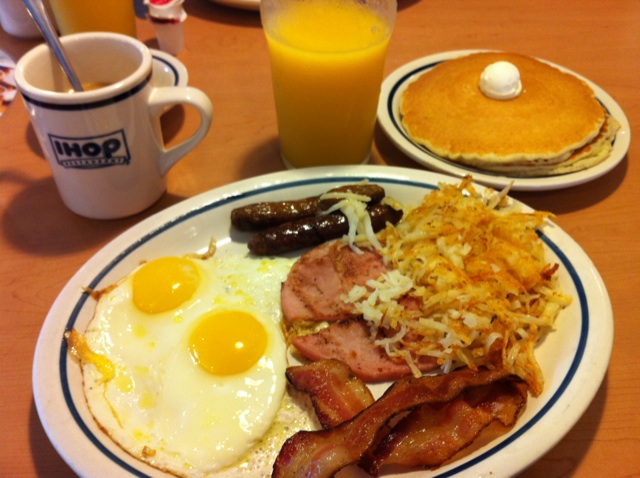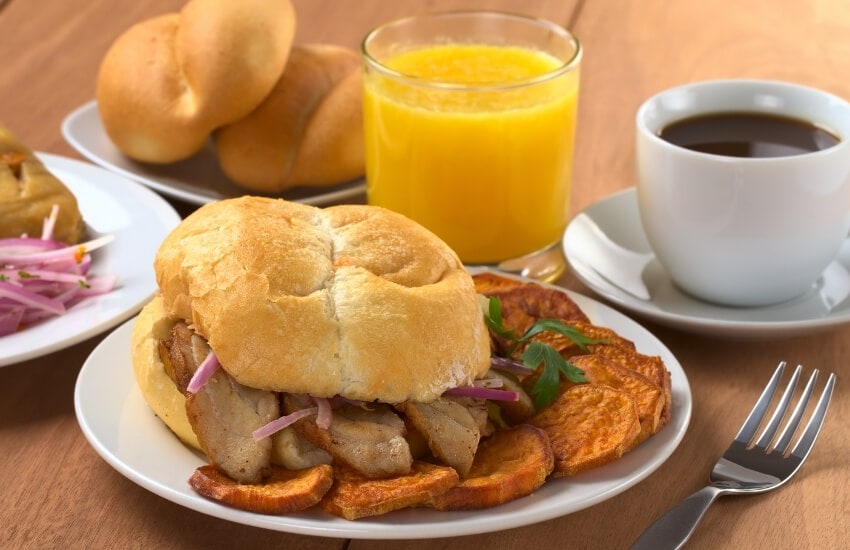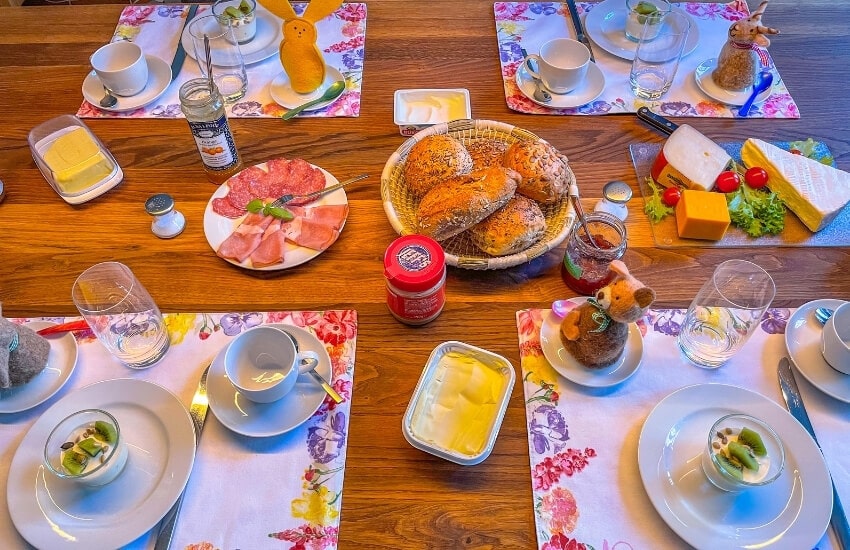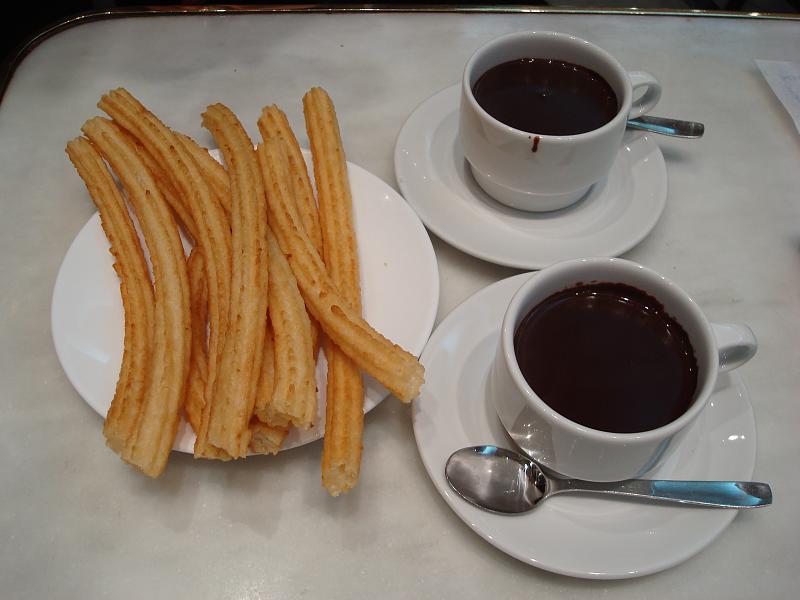
Avo on toast is a classic Australian brekkie and although you’re likely to associate it with trendy Melbourne’s cafe culture, it’s actually thought to have originated in my home city, Brisbane, where it appeared as early as 1929. This breakfast staple is urban Australia on a plate: Simple, tasty and easy to eat, with fresh produce at its heart. Avo is the hero of this dish – all that’s needed is a squeeze of lemon juice and a pinch of sea salt to bring out the flavour.

The ultimate in morning indulgences, breakfast in the US brings together elements from a range of different food cultures around the globe, fries them and smothers them in salt or syrup. There’s no one single ‘North American breakfast’, rather an All-American Breakfast captures a huge range of dishes arranged in different combinations depending on the region and the occasion.
Before the days of cereal and pop tarts, the first meal of the day was eaten together around the breakfast table (and still is in many households). A classic American breakfast resembles an English breakfast in some ways, and might include eggs, bacon, ham, sausages or steak and potatoes (hash browns for instance) served with toast, sweet baked goods such as muffins, black coffee and fruit juice on the side.

Calentado, a popular breakfast dish, stands out for two reasons: Firstly, it embodies the concept of zero food waste, and secondly, it plays perfectly to the conventional wisdom that everything tastes better the next day.
Calentado is essentially yesterday’s leftovers re-fried and served with fresh eggs and Arepas (cornmeal cakes). The exact composition varies depending on what you ate for lunch/dinner the previous day, but it might typically include chorizo, white rice and pinto beans finished with fried eggs and avocado.

The reputation of Peruvian cuisine around the world is growing fast. Blending historic traditions and homegrown ingredients with a diverse range of influences from different cultures over the centuries, there are so many delicious dishes to try! One classic is Pan con Chicharrón, traditionally eaten for breakfast.
Pan con Chicharrón is a sandwich made with fried pork belly and sweet potato rounded off with Salsa Criolla, a spicy onion relish. Its origins date back to the days of Spanish rule, when pigs were first introduced to the country.

The name of the dish in Nahuatl language (the Aztec language that predates Spanish) translates to ‘chillies and greens’. The modern day version of Chilaquiles can either be green or red and is printed on menus as Chilaquiles Verde or Chilaquiles Roja.
They’re cut up and fried then smothered in red or green salsa and topped with Crema (a fresh cream that’s neither sweetened nor soured), a fried egg, onions and queso fresco cheese (a crumbly variety with a mild flavour). Depending on the region of Mexico or family recipe, you may also find refried beans, chicken or avocado added to the mix.

One of the staples you’ll always find to accompany your meal is Gallo Pinto, a dish of rice and beans whose role resembles that of bread in Europe or plain rice in Asia. A typical Nicaraguan breakfast consists of eggs, Queso (a plain mild cheese), Gallo Pinto, a corn tortilla, a fresh juice and a coffee, of which Nicaragua is a producer.
Gallo Pinto is a national dish of both Nicaragua and Costa Rica, who each claim the recipe. According to Costa Rica, the dish came about in a suburb of San Jose in the 1930s. Nicaraguans on the other hand believe the dish was brought there by African slaves from the Caribbean.

Gallo Pinto is a mixture of cooked white rice and slow cooked beans. Either black beans or red beans can be used for the Pinto recipe. The dish is typically flavoured with a local condiment called Salsa Lizano and often garnished with pepper and coriander. Put together, this healthy and hearty meal is referred to as Desayuno Típico, meaning typical breakfast, and is always accompanied by a cup of coffee.
There is a never-ending debate about the origins of Gallo Pinto. Both Costa Rica and Nicaragua claim that the dish originated from their respective land and later spread beyond the border. Although there is no conclusive evidence, many people relate the red beans variant with Nicaragua and the black bean variant with Costa Rica.

Argentina, as a whole, isn’t a morning person. The country tends to wake lazily and ease into the day with a light breakfast. As with most traditional things to eat in Argentina, the European influence is obvious. Strong coffee and pastries are the most common breakfasts here, borrowed heavily from their Italian and Spanish immigrants of the early 20th century.
Among the many immigrants to Argentina were many anarchist and communist bakers. These rebellious bakers expressed their subservient views through their work. They named their Facturas after religious and military symbols. There are Vigilantes (named after the guards), Suspiro de Monja (nun’s sigh), and for a particularly cheeky one, Bolas de Fraile, or the friar’s balls.

A food tour can be the perfect introduction to breakfast culture. This is true in Cuba, where many tours begin with a traditional Cuban breakfast of Café con Leche (coffee with milk) and Pan Tostado (toasted bread). Variations of café con leche abound, but the traditional recipe uses equal parts steamed milk and freshly brewed espresso. This ratio differentiates café con leche from cappuccino that is typically a 1:2 ratio of coffee and foamed milk, and lattes that are a 1:3 ratio.
Some café con leche connoisseurs assert that the traditional recipe uses evaporated milk. Others insist on using whole milk. The espresso, without sugar, may be served alongside a cup of hot or steamed milk with sugar on the side. Cuban bread is usually made in long, baguette-like loaves similar to French bread. The all-white flour is mixed with lard or vegetable shortening to produce a heavier flavour, then the bread is toasted or grilled and served with butter.

The Full English Breakfast dates back to the 13th century, when it was reserved for the upper classes, but it later became very popular in ‘greasy spoons’ (cheap cafes in industrial areas serving hearty food to workers). Today it’s a tasty tradition in cafes and homes all over England.
A Full English Breakfast consists of fried eggs, black pudding, sausages, baked beans, bacon, tomatoes and mushrooms, with fried bread or buttered toast on the side. Optional extras include bubble and squeak or a hash brown. And it’s got to be washed down with an English breakfast tea, naturally.

The Full Irish Breakfast dates back to the 14th century and was considered a luxury. Later on, during the Industrial Revolution, it slowly became more and more available to the masses and was designed to provide enough energy to farmers and workers to keep them full throughout the day.
A typical Irish breakfast includes bacon, baked beans, pork sausages, fried eggs, buttered toast (soda bread), white pudding, black pudding, fried tomatoes, and mushrooms. Sometimes you can also get Boxty, which is a fried potato pancake. In the north, you can even find smoked salmon on the side.
Contrary to popular belief, a chocolate croissant is actually not a proper croissant and goes by the name Pain au Chocolat in France, which translates to ‘chocolate bread’. However, both regular croissants as well as pain au chocolat are commonly eaten for breakfast in France and in many other countries in the region. The croissant actually originated in Austria where it was invented some time in the 13th century by a local baker. He named it Kipferl and sold it as a so-called morning pastry.
Croissants are usually served with jam, butter, honey, and sometimes with chocolate spread. Although you can buy pre-packaged croissants at the grocery store, the authentic version can be found at French bakeries, called boulangerie. It’s quite common to pick up a fresh croissant on your way to work in France and even school kids tend to stop at the boulangerie in the mornings.
![]()
Belgian Waffles or Brussels Waffles are a typical breakfast tradition that you simply must try when visiting Belgium. Most waffles are served warm by street vendors, dusted with confectioner’s sugar. Belgians love to eat them in the morning served with whipped cream, chocolate spread and fruit, or in the afternoon with a scoop of fresh ice cream.
When in Belgium, definitely try the Liège Waffle, the Brussels Waffles’ oval-shaped cousin. While the Brussels Waffle is completely rectangular with perfectly shaped square holes and an airy batter, its Liège counterpart could be considered the more rebellious, alluring of the two. It’s made with brioche dough and has chunks of caramelised sugar inside.

Think of breakfast in Italy, and your mind will immediately run to ‘Cornetto e Cappuccino’, which Italians typically enjoy at a bar, Italian for café. Cornetto is a pastry that is similar in shape to a French croissant, but completely different in terms of texture (this isn’t nearly as flaky) and flavour. Cornetto is not as buttery, and is traditionally filled with apricot jam, vanilla custard or in more recent years chocolate or pistachio spread.
The tradition of enjoying a cappuccino for breakfast goes back longer than you’d imagine and started in the 17th century in the historic cafes of Venice. Cappuccino was actually invented in 1683 by Marco d’Aviano, a capuchin friar, by mistake.

The base of a German breakfast is bread rolls and even here, the options are endless: White bread, wheat bread, rye bread, multi-grain bread, dark bread, etc. Next up are the toppings. For savoury individuals, these are the essentials – ham, salami, and cheese. For sweet tooths, marmalades and jams, Nutella and honey are the desired toppings.
German breakfasts are typically served with eggs (boiled, scrambled, or fried), yogurt, fruit, orange juice and coffee. The best part of a German breakfast is walking into a dining room on a Saturday morning with a table full of food. A popular German regional breakfast is the Weißwurst Frühstück (White Sausage Breakfast). The main features of this breakfast are white sausages (don’t eat the skin!) along with pretzels, mustard and wheat beer.

Drinking a cold, sweet Horchata accompanied by fluffy Fartons is a must-have experience in Valencia, Spain. Not to be confused with Mexican Horchata (which is made from rice), Valencian Horchata is made from tiger nuts (Chufa), which were brought to Spain by the Arabs and are now grown in the adjacent town of Alboraya (and 15 other municipalities that form a Protected Designation of Origin).
Surprisingly, Fartons were only invented in the 1960s. The Polo family created this sugar-glazed bun especially so it would be the perfect pastry to dip in the Horchata. It’s incredibly airy to absorb the sweet drink, and it has an elongated shape to fit into the glass.

The dish is popular all over the country, especially in the Spanish city of Barcelona, where dozens of family owned cafe-bakeries known as Churreria specialise in star-ended Churros fried fresh to order. Like so many traditional foods, the exact origins of the Churro remain a mystery. Some food historians say they’re descended from Chinese Youtiao; others attribute the recipe to Spanish shepherds who would fry a simple flour-water-salt dough as a proxy for bread.
As you travel around Spain, you’ll encounter many different regional variations of the breakfast: Porras, a thicker Churro, are popular in Madrid, while in Granada you’ll likely meet the buttery Tejeringo. All come with thick, rich dunking chocolate on the side.
If you happen to travel to Sicily in the summer months, no doubt you will see people sitting out on the piazzas and in outdoor cafes and bars tucking into what at first glance looks like an ice cream sorbet. This semi-frozen Sicilian dessert is called a Granita, and it’s often eaten in the early morning. The island of Sicily is the home of Granita, a breakfast tradition that dates back as far as the Middle Ages.
These days you can find most bars and cafes serving granitas in a variety of different flavours, although some places use syrups in the place of fresh fruit juice. Popular versions include coffee, lemon, almond, strawberry, mixed berries and pistachio. Granita is always served with a warm brioche (a freshly baked milk bread) and a glass of water (although both are optional), and costs around €4 with table service.

Nothing beats a freshly baked Koulouri with a cup of Greek coffee to start the day well! Koulouri is a popular street food found across Greece beloved by locals looking for a quick breakfast on their way to the office. Koulouria are rings of golden-baked bread covered in toasted sesame seeds that are crispy on the outside and soft inside. They’re traditionally made with wheat flour, olive oil and sugar syrup.
The breakfast snack was first introduced to Thessaloniki during the Byzantine Empire by refugees who had fled from Asia Minor. Later, Koulouri could be found in Istanbul where they were called Koulouridis. Their popularity soon spread to Athens and Attica.

A unique breakfast tradition from the Netherlands is to have Hagelslag on a slice of bread. Hagelslag are delicious chocolate sprinkles with a very small and cylindrical shape. They take their name from the Dutch word for ‘hail’. This is a very popular breakfast in the Netherlands that is both loved by adults and children alike – especially chocolate lovers.
Hagelslag was created in the year 1913 by the company Venz, but became popular because of another company, De Ruijter. Nowadays, it’s hard to imagine a Dutch breakfast without it. Usually people spread butter on their bread first, so that the sprinkles don’t fall off when they are eating it. Hagelslag is made of pure chocolate and there are several versions of it: milk chocolate, dark chocolate (or pure chocolate in Dutch), and there’s even a version where both are mixed together.